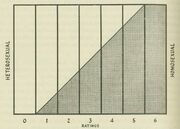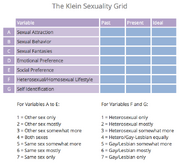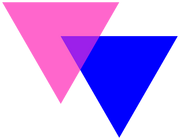(making a decision) |
m (Removed unsourced statements that need references) |
||
| Line 72: | Line 72: | ||
===Perceptions and Discrimination=== |
===Perceptions and Discrimination=== |
||
| − | Bi erasure is one of the most common ways to discriminate against bisexual people. It is the practice of obscuring or denying a bisexual individual's orientation, often in favour of portraying them as either gay/lesbian |
+ | Bi erasure is one of the most common ways to discriminate against bisexual people. It is the practice of obscuring or denying a bisexual individual's orientation, often in favour of portraying them as either gay/lesbian or straight.<ref name="GLAADbiE">{{Cite web|url=https://www.glaad.org/accordionview/bisexual-erasure|title=Bisexual erasure|publisher=GLAAD|date=2017-05-17|accessdate=January 25, 2022}}</ref><ref name="Bustle">{{Cite web|url=https://www.bustle.com/p/5-myths-about-bisexuality-that-contribute-to-bi-erasure-2418689|title=5 Myths About Bisxuality That Contribute To Bi Erasure|publisher=Bustle|author=Rodriguez-Cayl, Kyli|date=2017-09-22|accessdate=January 25, 2022}}</ref> It remains common, and despite efforts from bisexual activists, the cisheteronormative perception of the gender binary continues to affect how bisexuals are perceived.<ref>[https://www.taylorfrancis.com/chapters/edit/10.4324/9780203947470-45/sexual-prejudice-erasure-bisexuals-academia-media Sexual prejudice: The erasure of bisexuals in academia and the media]</ref> |
There is a tendency to ignore the existence of bisexuality and assume that a person who has a same-sex relationship or sexual intercourse once is homosexual. However, a study in 2012 found that 76.8% of participants categorised such people as bisexual. Still, they "perceived male targets (who expressed a one-time interest in the other sex) to be more homosexual than comparable female targets were judged to be".<ref>[https://www.tandfonline.com/doi/abs/10.1080/19419899.2012.749505 Social perception of bisexuality]</ref> Another study, published in 2021, mentioned that the authors researched the suggestion that "people stereotype bisexual women as truly heterosexual and bisexual men as truly gay" and found that "participants all perceived bisexual men as more attracted to men than to women. No such pattern emerged for bisexual women".<ref>[https://onlinelibrary.wiley.com/doi/abs/10.1002/ejsp.2773 Bisexual erasure: Perceived attraction patterns of bisexual women and men]</ref> |
There is a tendency to ignore the existence of bisexuality and assume that a person who has a same-sex relationship or sexual intercourse once is homosexual. However, a study in 2012 found that 76.8% of participants categorised such people as bisexual. Still, they "perceived male targets (who expressed a one-time interest in the other sex) to be more homosexual than comparable female targets were judged to be".<ref>[https://www.tandfonline.com/doi/abs/10.1080/19419899.2012.749505 Social perception of bisexuality]</ref> Another study, published in 2021, mentioned that the authors researched the suggestion that "people stereotype bisexual women as truly heterosexual and bisexual men as truly gay" and found that "participants all perceived bisexual men as more attracted to men than to women. No such pattern emerged for bisexual women".<ref>[https://onlinelibrary.wiley.com/doi/abs/10.1002/ejsp.2773 Bisexual erasure: Perceived attraction patterns of bisexual women and men]</ref> |
||
Revision as of 19:46, 3 February 2022
Bisexuality is the sexual attraction to two or more genders on the gender spectrum.[1][2] Some bisexual people have a preference toward one or several genders and some do not.[3]
Etymology
"Bisexual" comes from the roots "bi-", meaning "two" or "double", and "-sexual". The term "bisexuality", when referring to sexual orientation, was first used by neurologist Charles Gilbert Chaddock in his English translation of Psychopathia Sexualis in 1892, which contained a theory that the brain of a person attracted both to their own sex and the opposite sex must be partly of another sex and thus "hermaphroditic".[4] Earlier, it was a term in botany for "having male and female parts".[5]
Community
Bi Visibility Day is 23 September. It varies in several countries, though, being the 16th, 24th, or 25th instead.[6]
History
Ancient history
In Ancient China and Japan, homosexuality and bisexuality was also documented, both men who had sex with men, and women who had sex with women. There were ancient Japanese art prints, called shunga, which depicted sexual relationships in full detail, including same-sex relations. Ancient China had similar artwork.[7] Ancient Greek religious texts, which reflected cultural practices, had bisexual themes throughout. Ancient Greece is generally considered to have been accepting of LGBTQIA+ individuals, though the stance has differed in various city-states.[8] In terms of social acceptance in ancient Rome, a freeborn Roman man could have sex with both men and women, as long as he took the penetrative role.[9] Caligula, a Roman Caesar, had relationships with both men and women.[10][11]
19th Century
Starting from 19th century, historians documented multiple self-declared or openly living as bisexual historical figures, being able to describe them in more detail. These include several well known writers, singers and artists; however, living openly as a bisexual person was rare due to stigma. The famous writer Hans Christian Andersen (1805 - 1875) is described to be bisexual, as he describes attraction to both men and women in his correspondence and diary; his male love interests include Edvard Collin, who preferred women and found himself "unable to respond to this love".[12][13] Lord Byron (1788 - 1824), an English poet, one of the leading figures of the Romanticism, had many relationships with women, but also men and his bisexuality is acknowledged by historians.[14]
Early 20th Century
During the Harlem Renaissance, blues singers Ma Rainey (1886 - 1939) and Bessie Smith (1894 - 1937) openly included bisexuality in their lyrics and life and are considered bisexual.[15][16] Poet Edna St. Vincent Millay (1892 - 1950) was also openly bisexual.[17]
The Kinsey Scale

The Kinsey scale, originally created by Alfred Kinsey and published in his 1948 book Sexual Behavior in the Human Male.
The sex researcher Alfred Kinsey and his team published the Kinsey Scale in 1948, to illustrate that sexual attraction and behavior can vary on a wide spectrum. The seven-point scale ranges from 0 ("exclusively heterosexual") to 6 ("exclusively homosexual"). Those who fall somewhere in the 1-5 category are labelled as bisexual. The scale shows that there is a whole range of experiences other than being heterosexual or homosexual.[18][19]
1960s and 1970s
In New York, Philadelphia, and Washington, D.C., between 1965 and 1969 multiple pickets were staged to fight for the LGBTQIA+ rights. One woman at the second White House picket declared herself as bisexual.[20] Many bisexual individuals took part in the Stonewall riots in 1969, a key historical event for the entire LGBTQIA+ community. Brenda Howard, a known bisexual activist, is known as the Mother of Pride, because she created a one-month Stonewall anniversary rally in July 1969 and then took part in coordinating the Christopher Street Liberation Day Parade in 1970, known as the first pride march[21]
In 1972, a Quaker group (an American religious assembly), the Committee of Friends on Bisexuality, supported the bisexual people in the "Ithaca Statement on Bisexuality", being the possibly first know religious group to support the bisexual community in the United States of America.[22]
Freddie Mercury (1946 - 1991) is one of the most famous self-declared bisexual men. Many speculate about his sexuality, but it is known he came out to his girlfriend, Mary Austin, in 1976.[23][24]
The Klein Grid

The Klein Grid
It's also known as the Klein Sexual Orientation Grid (KSOG). The psychiatrist and sex researcher Fritz Klein published the Klein Grid in 1978 to provide a more nuanced way to describe human sexuality. It includes past and present experiences and one's "ideal" experience they'd wish to have, and multiple labels to describe the experiences. One can include their behavior, attraction, fantasies, lifestyle and preferences and describe them with with a multitude of labels containing words "only", "somewhat more", "most" and such. The grid illustrates fluidity and complexity of everyone's sexual identity.[19][25]
1980s and 1990s
When the HIV/AIDS pandemic began, bisexual activists fought for their recognition; they also fought for cis women, transgender people and injection drug users to be recognized as victims of the pandemic and supported. One of them was a Black woman, Veneita Porter, who advocated for these groups and was known to be bisexual; she was an activist of the Prostitute's Union of Massachusetts and the Call Off Your Old Tired Ethics organization.[26] In 1985, the Bisexual Resource Center (BRC) was founded as the East Coast Bisexual Network.[27] In 1987, the article "The Bisexual Movement: Are We Visible Yet?" by Lani Ka'ahumanu appeared in the official Civil Disobedience Handbook for the Second National March on Washington for Lesbian and Gay Rights and was the first article from the bisexual community in a national lesbian or gay publication in the United States of America.[28]
In 1992, Colorado voters approved the 1992 Colorado Amendment 2 that prevented any city, town, or county in the state from taking any legislative, executive, or judicial action to introduce anti-discrimination law protecting gay, lesbian, or bisexual people. The Supreme Court ruled in a 6–3 decision that the amendment did not satisfy the Equal Protection Clause.[29]
Modern history
The Union for Reform Judaism in 2003 issued a resolution "Support for the Inclusion and Acceptance of the Transgender and Bisexual Communities", which applied their policy supporting rights of the gay and lesbian communities to the bisexual and transgender communities.[30]
Flag
The bisexual pride flag was designed by a team led by LGBT activist Michael Page in 1998. The flag was created in order to give the bisexual community its own symbol which was easily recognized and comparable to the gay pride flag (rainbow flag) that represented the larger LGBTQIA+ community. Page's aim was to increase the visibility of bisexual people, both among society as a whole and within the community.[31]

The biangles
Page took the colors of the bisexual pride flag from an existing bisexual symbol, the biangles (bisexuality triangles).[31] The biangles were created for the Boston Bi Woman's Community by the artist Liz Nania.[32]
The pink color represents sexual attraction to the same sex only (gay and lesbian). The blue represents sexual attraction to the opposite sex only (straight) and the resultant overlap color purple represents sexual attraction to both sexes (bi).
Michael Page, The History of the Bi Pride Flag

The bisexual crescents
A number of bisexual people prefer to use the bisexual crescents (also called the double moon) instead of the bi triangles as their community symbol, as they want to avoid using a symbol that derives from the pink triangle, which was used to tag and persecute homosexual people in the Nazi regime. This symbol was created by Vivian Wagner with a team in 1998.[33]
Distinction
Bisexual people are distinct from, but similar to pansexual and omnisexual people. Bisexuality is attraction to more than one gender, while pansexuality is described as attraction to all genders regardless of gender; omnisexuality is attraction to all genders, where gender often still plays a role in one's attraction. However, the definitions are very nuanced and can vary per person.[2]
Perceptions and Discrimination
Bi erasure is one of the most common ways to discriminate against bisexual people. It is the practice of obscuring or denying a bisexual individual's orientation, often in favour of portraying them as either gay/lesbian or straight.[34][35] It remains common, and despite efforts from bisexual activists, the cisheteronormative perception of the gender binary continues to affect how bisexuals are perceived.[36]
There is a tendency to ignore the existence of bisexuality and assume that a person who has a same-sex relationship or sexual intercourse once is homosexual. However, a study in 2012 found that 76.8% of participants categorised such people as bisexual. Still, they "perceived male targets (who expressed a one-time interest in the other sex) to be more homosexual than comparable female targets were judged to be".[37] Another study, published in 2021, mentioned that the authors researched the suggestion that "people stereotype bisexual women as truly heterosexual and bisexual men as truly gay" and found that "participants all perceived bisexual men as more attracted to men than to women. No such pattern emerged for bisexual women".[38]
Media
According to GLAAD's report Where We Are on TV 16'-17':[39]
Of the 278 regular and recurring LGBTQ characters on scripted broadcast, cable, and streaming programming, 83 (30 percent) are counted as bisexual. This group is made up of 64 women and 19 men [...] In each of the examples listed, the character's identity as bisexual was directly tied to their manipulative and evil actions.
GLAAD, Where We Are on TV 16'-17'
Literature
- Chuck Bass in Gossip Girl
- Chass na Chadic in Star Wars novels
- Sabé in Star Wars novels
- Wyl Lark in Star Wars novels
- Yrica Quell in Star Wars novels
- Apollo in The Trials of Apollo
- Hemithea in The Trials of Apollo
- Josephine in The Trials of Apollo
- Lavinia Asimov in The Trials of Apollo
- Kitty Butler in Tipping the Velvet
- Armand in The Vampire Chronicles
- David Talbot in The Vampire Chronicles
- Lestat de Lioncourt in The Vampire Chronicles
- Louis de Pointe du Lac in The Vampire Chronicles
- Marius de Romanus in The Vampire Chronicles
- Luz Noceda from The Owl House
Film
- Harley Quinn in Birds of Prey (And the Fantabulous Emancipation of One Harley Quinn)
- Lorraine Broughton in Atomic Blonde
- Ramona Flowers in Scott Pilgrim vs. the World
Television
- Sara Lance in the Arrowverse
- Bo in Lost Girl
- Dio Brando in JoJo's Bizarre Adventure [40]
- Rosa Diaz in Brooklyn99.[41][42]
Comic Books
- Harley Quinn in DC Comics
- Tim Drake (Red Robin/the third Robin) in DC Comics
Music
- Bessie Smith
- Billie Joe Armstrong
- Dodie Clark
- Janelle Monáe
- Kehlani
- Lady Gaga
- Meshell Ndegeocello
Public figures
- Alia Shawkat
- Bai Ling
- Brenda Howard, the "Mother of Pride"
- Jack Dylan Grazer
- Javicia Leslie
- Jen Richards
- Joan Stokes
- Jon Cozart
- Kristen Stewart
- Margaret Cho
- Robin Ochs
- Sheryl Swoopes
